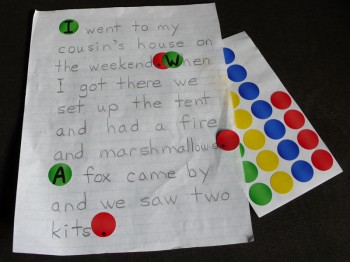Lesson Plans for Elementary School Students
Full Length Lesson Plans from an Elementary School Teacher
Writing Lesson Plan: Stop and Go: Capitals and Periods
 This is a fun and memorable way to remind students that sentences always begin with a capital and end with a period. I use 1/2 inch sticky labels in red and green to help students edit their writing. Students usually pick the longest story they can find to edit in their writing journals because they want to use lots of stickers. This is great because they get lots of practise.
This is a fun and memorable way to remind students that sentences always begin with a capital and end with a period. I use 1/2 inch sticky labels in red and green to help students edit their writing. Students usually pick the longest story they can find to edit in their writing journals because they want to use lots of stickers. This is great because they get lots of practise.
Objectives:
- students edit their writing looking for capitals and periods
- learn that sentences begin with a capital and end with a period
Materials:
- 1/2 inch sticky round labels in red and green
- pencils
- writing journals
- chartboard
- chart paper
- markers
- large red and green circles cut out of scrap construction paper to edit my story on the chartboard
- white glue to glue on my large red and green circles
Methods:
- Ahead of the lesson, I write a short story on the chartboard. (Usually when I print sentences of this board, each sentence is a different colour. See Homebook Books lesson under “writing”.) For this lesson, all the sentences blend together and have no capitals and no periods.
- For the lesson, I try to read my story to them, exaggerating and acting a bit, running out of breath and trying to read it all at once, puffing and panting at the end. I try really hard to stop and take breaths in the middle of thoughts, so it’s very difficult to follow the story. I try to make it as confusing as possible to understand what I’ve written.
- When I’m finished reading my story, I apologize for puffing and panting, explaining that I had lots of trouble reading my story to them. I tell them I kept losing my spot and forgetting where I was.
- Usually by then, students are telling me that I don’t have any periods in my story. If they aren’t telling me yet, I ask them if they can help me fix my writing so that it’s easier for me to read.
- We talk about why we need periods and capitals. It makes it easier to understand, to read, to follow the story. Periods allow us to catch our breath and pause for a moment. Capitals tell us it’s a new thought. They tell us when each new thought begins. It is less confusing and easier to understand when our writing is organized. (You can talk about paragraphs here too if you’d like.)
- I show students how I put a green circle at the beginning of each of my sentences, then print a capital letter on it. I put a red circle at the end of each thought and print a period on it.
- I ask students to choose one of their stories in the writing journal to edit with our red and green circle stickers. Students usually pick the longest story they can find because they want to use lots of stickers. This is great because they get lots of practise.
Tags: capitalization rules, capitals, editing, periods, sentences

I had the students write their own stories and then go back and add the dots. For a closure activity, I had them go to their writing notebooks and add the dots to a story they have previously written. This way they will notice other punctuation marks in their writing and will learn that a question mark and exclamation mark also lets them know to end a sentence. This will lead to later lessons on exclamations and question marks.